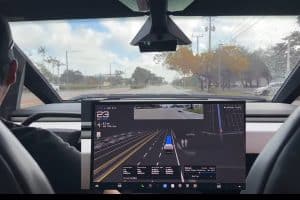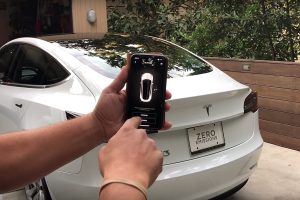A recent video from Gruber Motors gives us a glimpse at the future of the automotive repair scene. While many EV owners are familiar with how a Tesla service center (or other dealer repair) works, that’s only one small part of what we’re going to see develop over the next few years.
How Things Went With Hybrids
A year or so ago, my mom asked me if I was afraid to drive an EV. “The battery must be so expensive!” she said. When I asked her what made her think of this, she told me that someone in the family recently got rid of an older Toyota Prius. The problem? The car (in running order) was worth about $5,000, and the hybrid battery failed. My relative went to the dealer and got a quote of $3500 (out the door) to replace the hybrid’s relatively small pack. She traded the car in to the dealer for $500 and bought something else, and told my mom later that she’d never buy a hybrid again.
“Did you know she could have fixed it for $500-1000?” I asked.
My mom was shocked when I told her about independent Prius mechanics who will come to your house and swap the battery pack for a refurbished one for so cheap. They then take your broken Prius pack with them, swap out bad cells, and put that one in someone else’s car. They even have a year or two of warranty.
EVs are now starting to follow a similar path. There aren’t that many Teslas that are out of warranty. The original Roadster and some 2012-13 Model S vehicles are all there are right now. If a newer car completely quits moving, people take it to the service center and Tesla fixes it up under warranty. If something like a battery pack or drive unit fails, they replace the whole unit rather than tear it down and repair the failed component(s). Take an out of warranty Tesla that needs a new pack or drive unit, and expect to spend tens of thousands getting whole sections of the car replaced.
Just like the hybrids and gas cars before them, it’s always cheaper to take an out-of-warranty vehicle to an independent repair shop. In the video, Gruber Motors explains how it has taken a very different approach to repairing EVs than Tesla’s service centers, and how its approach is probably the future of independent EV repair shops.
A Very Different Approach
When something goes wrong with a Tesla vehicle, Tesla’s service centers take a very modular approach to vehicle repair. If a battery pack has a problem, they replace the whole pack. If a drive unit breaks, they replace the whole drive unit.
This is very different from the transmission shop I hung out in as a little kid. My dad had a pretty good business rebuilding transmissions, especially for commercial clients who would rack up over 100,000 miles per year on a vehicle. He’d bring the vehicle in, lift it, drop a transmission, take it completely apart, inspect/replace broken components, put in a new clutch and other parts that tend to wear fast, reassemble it, test it, and have the van or truck back on the road within a few days.
This approach keeps costs down. Instead of paying GM big bucks for a factory-new transmission, they’d pay for labor and only the parts/fluids that needed to be replaced. If the commercial outfits had to buy a new transmission every other year for their vans and trucks, they’d have a hard time affording that, but independent shops take care of people and keep vehicles on the road a lot longer.
Gruber Motors is doing the same thing with Teslas. Instead of replacing a whole battery pack, the company digs into it and figures out exactly what’s wrong. In other videos, he explains that sometimes it’s just a few bad cells that need replaced, and the vehicle comes back to life. It’s also clear that many other things can go wrong, so they have electronics technicians on staff to dig deep and make only the needed repairs.
Future Repair Shops Will Be Very Different Than The Old Ones
Unlike repairing vehicles in the 1980s, what needs repaired is very different with today’s electric vehicles.
Mechanical problems do happen with EVs, but they’re relatively rare because there are so few moving parts. If something goes wrong, it’s more often going to be an electronic problem. Pete Gruber shows how different his shop is from most small auto repair shops today. There’s a large area with just electronics repair and diagnosis going on. In the garage, there aren’t oil stains on the ground or smells, but there are oscilloscopes, laptops, and a variety of electronic tools that you typically wouldn’t see at the local mechanic’s garage.
The skills needed are also quite different. Auto repair shops will always need people to turn a wrench like they do today, but independent EV repair shops will need people with a lot more skill in electronics. Even Tesla needs people with different skills, so it partners with community colleges to train people up in the skills they need to know, even if they aren’t going to be digging deep the way people at Gruber Motors do.
So, the independent shops are going to need people with even more skills. The people who get those skills will be very valuable for the next several decades as more EVs come out of warranty.
Another Model We Might See
I personally don’t think every independent EV repair shop will be doing the specialized things that the people at Gruber Motors are doing. For at least part of the industry, there is likely to be more of a hub-and-spoke topology.
Some local EV shops will do what Gruber is doing, and do all of their deepest repairs in-house, but many will not have the skill to do all that, especially if the volume of business is low. Instead, they’ll probably do something a little more similar to what Tesla’s service centers are doing, but for a lot cheaper.
It might make more sense for the people with relatively rare skills (deep electronic repair) to be rebuilding and refurbishing broken things at a specialized facility. When a small independent shop needs to replace a battery pack, they can order in a refurbished replacement for a fraction of what Tesla charges for a new pack. On top of that, they’ll pay a core charge. When they ship in the broken pack for the facility to refurbish for the next customer, they’ll get the core charge refunded.
At present, that’s how it works for many automotive parts. You can buy a new alternator, or you can order in a refurbished or remanufactured unit for a lot cheaper. The same is true for water pumps, some types of batteries, and many other automotive parts. The machining and rebuilding that take specialized skill happens in just a handful of places while independent shops and DIY mechanics take advantage of that skill globally.
The other benefit to this is for the customer. When there’s a high volume of EV repair business, drivers will appreciate the ability to get their car back within a day or two instead of waiting on complex repairs. Their local mechanic puts a refurbished pack in fast, and then sends the busted one for complex repair to be used for another customer.
Either way, it’s great to see that effort is going in to make sure EVs have a future when they’re more than 8-10 years old. Keeping EVs on the road is a great way to reduce their environmental impact even further, and we all benefit from that.





